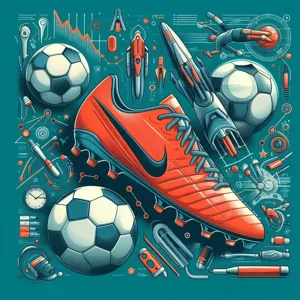Tennis is as much a mental game as it is a physical one, and the ability to stay composed under pressure can make all the difference between victory and defeat.
As you step onto the court, the stakes can feel high—whether you’re competing in a friendly match or a high-stakes tournament, the pressure can mount quickly. Many players find themselves overwhelmed by nerves, leading to mistakes that could have been easily avoided. In this post, we will explore essential tips and techniques to help you master the moment and maintain your composure, no matter what challenges come your way. From breathing exercises that center your focus to strategic mental frameworks that enhance your game, you’ll discover practical strategies to help you thrive under pressure and elevate your performance on the court. Join us as we delve into the art of staying calm and collected, ensuring that you can play your best when it matters most.
1. Understanding Pressure in Tennis: What It Means and Why It Matters

Pressure is an inescapable aspect of competitive tennis, and understanding its nuances can be the key to mastering your performance on the court. At its core, pressure in tennis arises from the weight of expectations—both self-imposed and external. Players often grapple with the desire to perform their best, whether it’s to secure a victory, impress spectators, or fulfill personal ambitions. This amalgamation of expectations can create a palpable tension that influences not only how you play but also how you think and feel during critical moments of a match.
Recognizing what pressure means is crucial. It’s not just the anxiety you feel when the score is tight, or when you’re serving for the match. It encompasses the anticipation that builds throughout a tournament, the mental chatter that can distract you during points, and the physical sensations—like increased heart rate or shallow breathing—that can throw you off your game. Understanding pressure allows you to identify its sources and develop strategies to effectively manage it.
Why does pressure matter? In tennis, where matches can hinge on single points or fleeting moments of brilliance, the ability to remain composed can set apart the good players from the great ones. By embracing pressure rather than shying away from it, you cultivate resilience and mental fortitude. This mindset not only enhances your performance during tense situations but also shapes your overall approach to the game. When you learn to view pressure as a challenge rather than a threat, you empower yourself to seize the moment, play with confidence, and ultimately, enjoy the game more deeply. Understanding pressure is the first step toward mastering it; it’s about transforming anxiety into energy and uncertainty into opportunity.
2. The Psychology of Performance: How Mindset Affects Your Game
In the high-stakes world of tennis, where every point can feel like a make-or-break moment, the psychological aspect of performance is just as crucial as physical prowess. Your mindset can mean the difference between winning a match and letting it slip away, often in the blink of an eye. Understanding how your thoughts, emotions, and mental strategies influence your game is essential for mastering the court under pressure.
A positive mindset fosters resilience, allowing you to bounce back from mistakes and maintain focus when the heat is on. Visualization techniques can be particularly effective; envisioning yourself executing perfect serves or winning crucial points can boost your confidence and reduce anxiety. When you step onto the court with a clear mental picture of success, you’re more likely to perform at your best.
Moreover, recognizing and managing negative thoughts is key. Every player faces moments of doubt, but how you respond to these thoughts can shape the outcome of the match. Techniques such as mindfulness and deep-breathing exercises can help ground you during intense moments, calming racing thoughts and allowing you to refocus on the task at hand.
Additionally, setting realistic goals for each match—whether it’s to maintain your serve percentage or to stay engaged during long rallies—can provide structure to your game and keep you focused, even when the pressure mounts. By cultivating a strong mental game, you can transform the way you approach tennis, empowering yourself to meet challenges head-on and perform with poise, no matter the circumstances. Remember, the court is as much a mental battlefield as it is a physical one, and mastering your mindset is a crucial step toward achieving your tennis aspirations.
3. Pre-Match Routines: Setting the Stage for Success

A well-crafted pre-match routine can be the cornerstone of a successful performance on the tennis court. It’s not just about physical preparation; it’s also a mental warm-up that allows you to enter the match with confidence and clarity. Think of this routine as your personal ritual—something that centers you and sets the tone for the challenge ahead.
Start by establishing a consistent warm-up routine that includes physical exercises tailored to your needs. Stretching, light jogging, and specific tennis drills can enhance your mobility and get your muscles primed for action. This physical preparation helps ease tension in your body, allowing you to move more freely and react quicker during the match.
However, it’s equally important to incorporate mental strategies into your pre-match routine. Visualization techniques can be particularly effective; spend a few moments imagining yourself executing your shots flawlessly, winning points, and maintaining focus throughout the match. This mental imagery can boost your confidence and help reduce anxiety.
Another beneficial element is the use of positive affirmations. Repeating phrases like “I am prepared” or “I can handle pressure” can help reinforce a positive mindset. Consider listening to calming music or engaging in mindfulness exercises such as deep breathing before you step onto the court. These practices can clear your mind of distractions and anxieties, enabling you to face the competition with a calm and collected demeanor.
Finally, arriving at the venue early allows you to acclimate to your surroundings. Take time to familiarize yourself with the court conditions and visualize the match unfolding in your mind. By creating a pre-match routine that incorporates both physical and mental elements, you set the stage for success, ensuring that when the moment arrives, you’re ready to conquer it with poise and focus.
4. Breathing Techniques: Harnessing Your Breath to Stay Calm
In the high-stakes environment of competitive tennis, where every point can swing the momentum of a match, mastering your breath is one of the most effective tools you can wield to maintain composure. Breathing techniques are not just about inhaling and exhaling; they are about harnessing your breath to create a sense of calm amidst the chaos of the court.
Start by practicing deep belly breathing, which involves inhaling slowly through your nose, allowing your diaphragm to expand fully. Feel your abdomen rise as you fill your lungs with air, and then exhale gently through your mouth, releasing any tension. This technique can help lower your heart rate, reduce anxiety, and keep your mind focused on the game rather than the pressure of the moment.
Incorporating rhythmic breathing can also be beneficial during crucial points in a match. For instance, synchronize your breath with your movements—inhale deeply before your serve or a critical shot, and exhale slowly as you execute. This creates a calming rhythm that centers your mind and body, allowing you to approach each play with clarity and intention.
Additionally, visualization paired with breathing can enhance your mental game. As you breathe deeply, visualize yourself executing a perfect serve or responding to an opponent’s powerful shot. Picture the ball coming toward you in slow motion, allowing your breath to guide your focus and concentration. This mental imagery can transform your anxiety into confidence, helping you stay grounded in the moment.
By making breathing techniques a regular part of your training routine, you’ll develop a reliable strategy to combat nerves and maintain a steady mindset, enabling you to perform at your best, even when the pressure is on. Remember, every match is a test of not just your physical skills, but your mental resilience—and mastering your breath is a crucial step in winning that battle.
5. Visualization: Imagining Success to Reduce Anxiety

Visualization is a powerful mental technique that can significantly enhance your performance on the tennis court while reducing anxiety. By picturing yourself succeeding in various match scenarios, you not only prepare your mind for success but also create a sense of familiarity that can alleviate stress during high-pressure moments.
Before stepping onto the court, take a few minutes to close your eyes and visualize a successful match. Imagine yourself serving effortlessly, hitting powerful groundstrokes, and executing your strategy flawlessly. Visualize the sounds of the crowd, the feel of the racket in your hand, and the satisfaction of winning crucial points. This mental rehearsal helps to program your brain for success, instilling confidence that can carry over into your actual performance.
To make this practice even more effective, incorporate all your senses into the visualization process. Picture the sunlight glistening off the court, the smell of fresh grass or clay, and the sound of the ball as it strikes your racket. The more vivid and detailed your imagery, the more effective it will be in calming your nerves.
Consider creating a visualization routine that you can use both in practice and before matches. By consistently engaging in this practice, you’ll cultivate a mental toolkit that not only prepares you for success but also helps you manage the anxiety that often accompanies big matches. Remember, the mind is a powerful ally; by visualizing success, you can transform your anxiety into a focused, confident performance on the court.
6. Focus Techniques: Keeping Your Eye on the Ball
In the fast-paced environment of a tennis match, maintaining focus can be a challenge, especially when the pressure mounts in crucial moments. One of the most effective focus techniques to enhance your performance is the simple yet powerful mantra: “Keep your eye on the ball.” This age-old advice is more than just a cliché; it’s a foundational principle that can help you regain composure and clarity when the stakes are high.
To implement this technique effectively, start by honing your ability to track the ball from your opponent’s racket all the way to your own. This practice not only heightens your awareness of the game but also allows you to anticipate your opponent’s next move, giving you a strategic edge. As the ball approaches, consciously remind yourself to breathe deeply and relax your grip. This will help you to remain steady and focused, rather than succumbing to anxiety or distractions.
In addition to visual focus, consider incorporating a pre-serve or pre-return routine to ground yourself. This could be as simple as bouncing the ball a few times or adjusting your strings. Such rituals can serve as mental anchors, helping to center your thoughts and transition your focus back to the task at hand.
Finally, visualize success. Before each point, take a moment to picture yourself executing the perfect shot. This mental imagery can boost your confidence while simultaneously keeping you present in the moment. By channeling your energy into the ball and the court, rather than the crowd or the score, you create a mental space that fosters calmness and clarity, allowing you to perform at your best under pressure.
Mastering these focus techniques will not only improve your game but also enhance your overall enjoyment of tennis, transforming high-pressure situations into opportunities for triumph.
7. Positive Self-Talk: Overcoming Negative Thoughts

In the high-stakes environment of a tennis match, the mind can be just as challenging as the opponent across the net. Negative thoughts can creep in, sowing seeds of doubt and anxiety at the worst possible moments. This is where the power of positive self-talk comes into play, serving as a mental shield against negativity.
Start by recognizing those detrimental thoughts as they arise. Instead of allowing them to spiral, counter them with affirmations that reinforce your abilities and resilience. For example, if you find yourself thinking, “I always choke under pressure,” reframe that thought to something empowering, like, “I thrive in challenging situations.” This simple shift can dramatically alter your mindset and performance.
Incorporate specific phrases that resonate with you, such as “I am strong,” “I am ready,” or “I play my best tennis when I’m focused.” Repeating these affirmations during practice and matches can help embed them in your subconscious, creating a strong foundation of confidence.
Moreover, visualizations can enhance the effectiveness of your self-talk. Before stepping onto the court, take a moment to picture yourself playing successfully, executing your shots with precision and grace. Pair this visualization with your positive affirmations to create a powerful mental rehearsal that builds your confidence.
Remember, the goal is to create a mental environment that fosters resilience and composure. By consciously choosing to engage in positive self-talk, you are not only boosting your confidence but also establishing a mindset that can handle the pressures of the game. Embrace the challenge, keep your thoughts constructive, and watch as your performance improves under pressure.
8. The Importance of Practice: Building Confidence Through Repetition
When it comes to mastering the mental game of tennis, the importance of practice cannot be overstated. Repetition is the cornerstone of building confidence, allowing you to hone your skills and develop muscle memory that can carry you through the most intense moments on the court. Each time you step onto the practice court, you aren’t just hitting balls; you’re crafting your own safety net for high-pressure situations.
Consider the rhythms and routines of a great musician. Just as a pianist practices scales to achieve fluidity and ease during a performance, a tennis player must engage in repetitive drills—serves, volleys, and groundstrokes—to ensure that every motion is second nature. This level of preparation allows you to trust your instincts when the stakes are high, reducing anxiety and allowing you to focus on strategy rather than mechanics.
Moreover, practice is not solely about physical repetition; it’s also a mental exercise. By simulating match conditions in your drills—whether it’s imagining a crowd cheering or playing against a fierce opponent—you can train your mind to remain calm and composed. Incorporating situational drills that mimic critical points in matches will help you familiarize yourself with the pressure and develop coping strategies to handle it effectively.
As you build confidence through consistent practice, you’ll find that your self-belief grows alongside your skills. You’ll enter matches with a sense of assurance, knowing that you have put in the time and effort to prepare. When those crucial moments arise—like facing break points or serving for the match—you’ll be equipped not just with technical ability, but with the unshakeable confidence that comes from dedicated repetition. Embrace the grind of practice, for it is the key to mastering the moment on the tennis court.
9. Mindfulness on the Court: Staying Present During Matches
In the high-stakes world of tennis, where every point can mean the difference between victory and defeat, maintaining a sense of calm and focus is essential. Practicing mindfulness on the court allows players to stay present during matches, reducing anxiety and enhancing performance. But what does mindfulness look like in the context of a tennis match?
First and foremost, it involves tuning into your body and breath. Before each serve, take a moment to center yourself. Close your eyes briefly, inhale deeply through your nose, and exhale slowly through your mouth. This simple act of breathing can ground you, helping you shake off distractions and hone in on the game. As you prepare for each point, focus on the feel of the racket in your hand, the texture of the court beneath your feet, and the sound of the ball as it connects with your strings. This sensory awareness keeps your mind anchored in the present, allowing you to react instinctively rather than overthinking your next move.
Mindfulness also encompasses the ability to let go of previous points—good or bad. Whether you’ve just executed a perfect drop shot or missed an easy volley, holding onto those moments can cloud your judgment and distract you from the current game. Instead, practice releasing those thoughts. Acknowledge your feelings—excitement, frustration, or even doubt—but don’t let them linger. Visualize them as clouds passing through the sky; appreciate them for a moment, and then let them drift away.
Incorporating mindfulness into your pre-match routine can also set the tone for your performance. Consider spending a few minutes in meditation or visualization, imagining yourself playing confidently and calmly. Picture yourself navigating high-pressure moments with grace and poise, and let that mental imagery resonate throughout your match.
Ultimately, mindfulness on the court is about cultivating a state of awareness that allows you to respond to each situation with clarity and confidence. By staying present, you’ll not only improve your performance but also enjoy the game more fully, transforming pressure into opportunity with every swing of your racket.
10. Handling Mistakes: Turning Errors into Learning Opportunities
Mistakes are an inevitable part of tennis, and how you handle them can make all the difference in your performance and mindset on the court. Instead of viewing errors as failures, embrace them as valuable learning opportunities that can enhance your game in the long run. When you miss a shot or double-fault, take a deep breath and shift your focus from frustration to analysis. Ask yourself what went wrong: Was it your footwork? Did you misjudge the ball? Understanding the root cause of your mistake allows you to make adjustments and refine your technique.
One effective strategy is to adopt a growth mindset, which encourages you to see challenges and setbacks as opportunities for improvement. After each match or practice session, take a moment to reflect on your performance. Jot down the key mistakes you made and consider how you would approach similar situations differently in the future. This self-reflection not only helps you learn but also builds your resilience, making you more prepared to face pressure in subsequent matches.
Additionally, consider incorporating visualization techniques into your routine. Picture yourself executing shots successfully after making an error, reinforcing the belief that you can recover and perform well despite setbacks. This mental rehearsal can bolster your confidence and help you maintain focus during high-stakes moments.
Remember, even the greatest players in the world make mistakes. How they respond to those errors often sets them apart. By cultivating a constructive attitude towards mistakes, you can transform moments of pressure into stepping stones for growth, ultimately mastering the art of remaining calm and composed on the tennis court.
11. Managing Expectations: Balancing Ambition with Realism
In the heat of a tennis match, the pressure can feel insurmountable, especially when you’re striving to meet high expectations—whether those are your own or set by coaches, peers, or the relentless pursuit of victory. However, managing expectations is crucial to maintaining composure and ensuring optimal performance on the court. Balancing ambition with realism doesn’t mean you should lower your goals; instead, it’s about setting achievable milestones that lead to your larger aspirations.
Begin by assessing your current skill level and understanding the realistic steps needed to reach your goals. This self-awareness allows you to develop a training regimen that challenges you without overwhelming you. For instance, instead of fixating on winning a tournament, focus on improving a specific aspect of your game, like your serve or footwork. Celebrate the small victories, such as consistently landing your first serve or executing a new strategy during practice. These incremental achievements build confidence and reduce the anxiety that can come from aiming too high, too soon.
Moreover, consider the importance of mental flexibility. Tennis matches are unpredictable, and the ability to adapt is vital. Remind yourself that setbacks are a part of the game; even the best players face defeats. By reframing your mindset to view challenges as opportunities for growth rather than as failures, you can alleviate the pressure that comes from rigid expectations. When you step onto the court, carry with you the understanding that it’s not just about winning—it’s about improving, learning, and enjoying the game. Striking this balance will not only enhance your performance but also help you stay calm and composed under pressure, allowing you to truly master the moment.
12. Strategies for Dealing with Difficult Opponents
Facing a difficult opponent on the tennis court can feel like stepping into a storm; the pressure mounts, distractions arise, and the stakes are high. However, mastering your response to challenging adversaries is crucial for maintaining composure and performing at your best. Here are some effective strategies to help you navigate these tough encounters.
**1. Focus on Your Game:** When confronted with a challenging opponent, it’s easy to get caught up in their strengths or intimidating demeanor. Instead, redirect your focus inward. Concentrate on your game plan, your strengths, and the techniques that you excel at. Establishing a mental checklist of your preferred shots and strategies can ground you amidst the chaos, helping you stick to what you know works best.
**2. Embrace the Challenge:** Shift your mindset from viewing a difficult opponent as a threat to seeing them as an opportunity for growth. Each challenging match is a chance to learn and improve your skills. Embracing this perspective can reduce anxiety and foster a more positive approach to the match, allowing you to play with confidence rather than fear.
**3. Breathe and Reset:** When the pressure rises, take a moment to breathe deeply. This simple act can calm your nerves and clear your mind. Incorporating breathing techniques into your routine—such as inhaling for four counts, holding for four counts, and exhaling for four counts—can help you reset your focus and regain control of your emotions.
**4. Use Positive Self-Talk:** The dialogue you have with yourself can significantly impact your performance. Replace negative thoughts such as “I can’t handle this” with affirmations like “I am capable” or “I thrive under pressure.” This positive self-talk can empower you to push through tough moments and maintain your composure on the court.
**5. Control the Pace:** If your opponent is aggressive and playing at a fast pace, use your serve and return to take control of the rhythm. Slow down the game when necessary by taking your time between points or using strategic pauses to regroup. By controlling the pace, you can disrupt their momentum while allowing yourself to regain composure.
By implementing these strategies, you can transform the pressure of facing difficult opponents into a powerful tool for resilience and growth. Remember, every match is an opportunity to hone your mental fortitude, and with practice, you’ll find yourself mastering the moment, no matter how tough the competition.
13. The Role of Physical Preparation: Conditioning Your Body and Mind
Physical preparation is a cornerstone of staying calm under pressure on the tennis court. Conditioning your body and mind not only enhances your performance but also fortifies your mental resilience when the stakes are high. Engaging in a comprehensive training regimen that includes both cardiovascular fitness and strength training can significantly improve your stamina and power, allowing you to maintain your energy levels throughout a grueling match.
But it’s not just about the physical aspect; mental conditioning is equally essential. Techniques such as visualization and mindfulness can help you develop a focused mindset, enabling you to remain present during critical points of the game. Imagine yourself successfully executing your shots or managing high-pressure situations with poise. This mental rehearsal prepares your brain for the real thing, reducing anxiety and fostering confidence when you step onto the court.
Moreover, incorporating a regular practice routine that mimics match conditions can help desensitize you to the pressure of competition. By training under simulated stress—such as playing with a clock ticking down or in front of a lively audience—you can teach your body and mind to respond calmly and effectively when the match is on the line.
Finally, don’t overlook the importance of recovery. A well-rested body and mind are better equipped to handle the demands of a match. Prioritize restorative practices such as stretching, yoga, and adequate sleep to ensure you’re at your best every time you compete. By focusing on both your physical conditioning and mental preparedness, you’ll not only enhance your performance but also cultivate an unshakeable calm that can carry you through the toughest moments on the court.
14. Post-Match Reflection: Analyzing Performance to Improve Future Results
Post-match reflection is a crucial step in the journey of every tennis player, serving not just as a means of understanding what went wrong, but as an opportunity for growth and refinement. After the adrenaline of the match has faded, take some time to sit quietly and sift through the emotions and events that unfolded on the court. This process is akin to a personal debriefing session; it’s your chance to step back and view the match from an analytical perspective.
Start by reviewing key moments in the match—those pivotal points that swung momentum or changed the course of the game. Ask yourself questions like, “What strategies worked well?” and “Where did I falter?” Consider the effectiveness of your serve, your footwork, and your shot selection. Was there a specific serve that consistently caught your opponent off-guard, or a particular return that you struggled with?
It can also be beneficial to keep a match journal, where you jot down your thoughts and observations immediately after the match. This record will serve as a valuable resource for future training sessions and matches, allowing you to track your progress over time. Additionally, consider reviewing video footage of your match if available. Watching yourself play can provide insights you might not notice in the heat of the moment, revealing patterns in your gameplay that need adjustment.
Finally, don’t forget to celebrate your successes, no matter how small. Acknowledging what you did well reinforces positive behaviors and builds confidence for your next match. By systematically analyzing your performance, you’ll not only enhance your skills but also cultivate a mindset that thrives under pressure. Embrace this reflective process as an essential part of your tennis journey, and watch as it transforms your game, making you more resilient and adept on the court.
15. Conclusion: Embracing the Challenge and Enjoying the Game
As we wrap up this exploration of staying calm under pressure on the tennis court, it’s essential to embrace the challenge rather than shy away from it. Every match presents a unique set of circumstances, and how you respond to the pressure can define not only your performance but also your enjoyment of the game. Remember that tennis, at its core, is a sport—a celebration of skill, strategy, and camaraderie.
Embracing the challenge means shifting your perspective from viewing pressure as a threat to seeing it as an opportunity for growth. Each intense point, every nerve-wracking serve, can be a chance to learn something new about your game and yourself. Use the techniques discussed, from breathing exercises to mental visualization, to equip yourself with the tools needed to maintain composure when the stakes are high.
Moreover, cultivating a love for the game can transform your approach to competition. Focus on the joy of playing, the thrill of hitting that perfect shot, and the camaraderie shared with your opponents and teammates. When you prioritize enjoyment over the outcome, you’ll find that pressure becomes more manageable and—dare we say it—enjoyable.
So, as you step onto the court, remember to take a deep breath, stay present, and relish the experience. Each match is not just a test of skill but an opportunity to embrace the challenge, grow as a player, and most importantly, enjoy the beautiful game of tennis.
As we conclude our exploration of mastering the moment on the tennis court, we hope these essential tips empower you to embrace the intensity of competition with a calm and focused mindset. Whether it’s harnessing your breathing techniques, visualizing success, or developing a resilient pre-match routine, every strategy can be a game-changer when the pressure is on. Remember, staying calm is not just about controlling your nerves—it’s about unlocking your full potential and allowing your skills to shine. The next time you step onto the court, carry these insights with you, and transform those high-stakes moments into opportunities for excellence. Happy playing, and may every match bring you closer to the player you aspire to be!




































